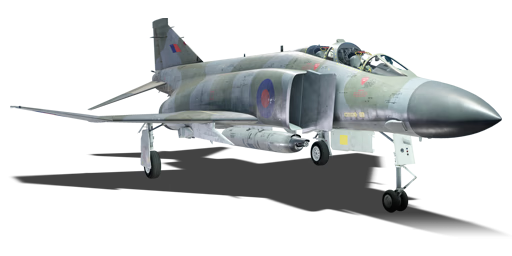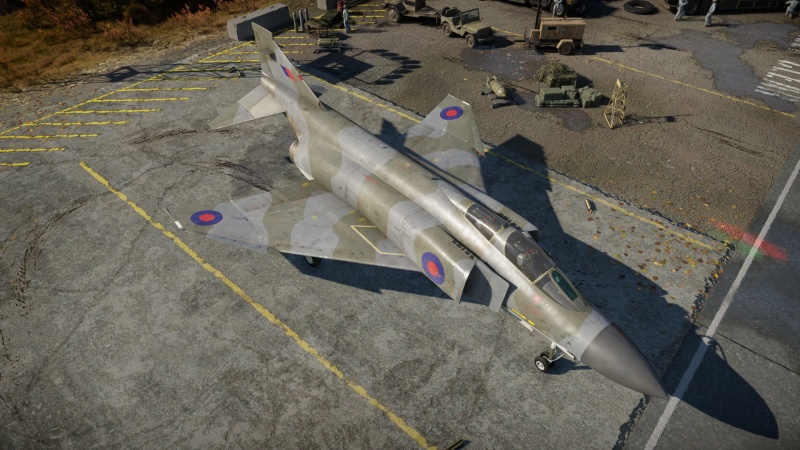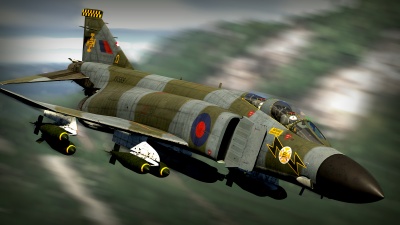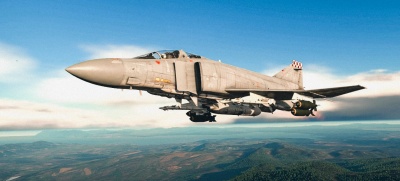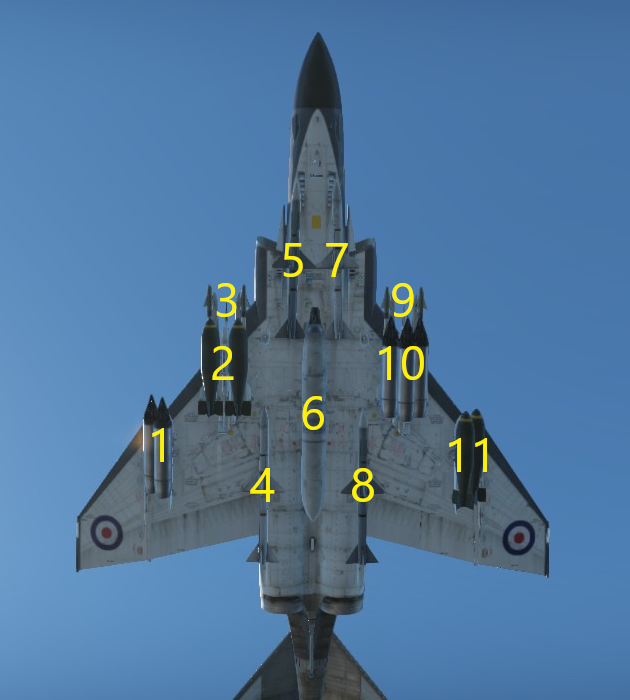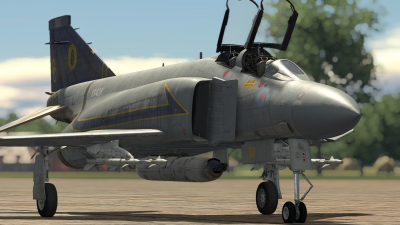Phantom FGR.2
| This page is about the jet fighter Phantom FGR.2. For other versions, see F-4 Phantom II (Family). |
Contents
Description
The Phantom FGR.2, also known as the F-4M, is a rank VII British jet fighter with a battle rating of 11.0 (AB), 11.3 (RB), and 10.7 (SB). It was introduced in Update 1.93 "Shark Attack". It is a British version of the American F-4 Phantom II.
Although at first glance the Phantom FGR.2 appears very similar to its American counterpart the F-4C Phantom II, there are a number of major visual and performance differences between the two aircraft. Phantoms produced for the RAF were redesigned to use British Rolls-Royce Spey turbofan engines, instead of the General Electric J79 turbojet engines found on American Phantoms. The British engines produced more thrust than the American engines, but were larger; as a result, the fuselage of British Phantoms was modified to be slightly wider than on the American models. In addition, the Phantom FGR.2 has larger air intakes than the F-4C, in order to allow for the increased airflow required by the new engines. The rear of the Fuselage is also significantly different on the Phantom FGR.2; the engines are noticeably angled downwards, and due to the different afterburner arrangement on the Spey engines the exhaust ports and the surrounding area were redesigned. Most distinctively, the Phantom FGR.2 has a squared-off tail and lacks the under-nose probe of the F-4C.
In-game these changes mean that the Phantom FGR.2 has much better low altitude acceleration and climb rate, compared to the F-4C, as a result of the more powerful engines. In games you will usually see the Phantom FGR.2s get off the ground and to altitude quicker than the F-4Cs; however due to the increased drag of the redesigned fuselage, and the performance characteristics of the Spey engines, it does not perform quite as well as the F-4C at high altitude, and cannot reach the same maximum speed.
General info
Flight performance
The Phantom FGR.2 is a large and heavy aircraft (more than twice the weight of a MiG-21), but there are times when you would hardly know it. The Phantom's two Rolls-Royce Spey turbofans are one of the most powerful jet engines in the game and give it an incredible thrust to weight ratio, leading to the Phantom FGR.2 being the fastest accelerating, and flat out fastest aircraft in the game at low altitude, while also being a strong contender for the fastest climbing. On take-off even stock FGR.2s will be the first aircraft to get off the ground and make it top the end of the runway (usually be a decent margin); while in terms of flat out speed a fully upgraded FGR.2 will push Mach 1.22 along the deck, a good bit faster than any other aircraft. The Phantom also climbs incredibly well, when loaded with 20m of fuel, missiles and a gunpod it can accelerate past Mach 1 in a 20° climb and even gain speed in a 50° climb (until it reaches about 2,000 m altitude); only few aircraft make it to altitude as fast as / faster than the FGR.2.
While the Phantom FGR.2 is certainly not the most manoeuvrable fighter in the game it can prove to be more agile than you would expect at low altitude. While you shouldn't be getting into full blown turn fights the Phantom handles very nicely when down low and can pull some manoeuvres with surprisingly little speed loss (mainly thanks to the amount of engine power you have).
Where the Phantom FGR.2 suffers is at higher altitudes, the Spey engines perform worse at altitude and the structural changes to accommodate them caused increased drag; this makes it slower than the American F-4C. At high altitude the FGR.2 loses the agility it had at lower altitude, and generally does not handle as nice. While it is still flyable evasive manoeuvres become harder and the turn radius is much larger.
| Characteristics | Max Speed (km/h at 10,667 m) |
Max altitude (metres) |
Turn time (seconds) |
Rate of climb (metres/second) |
Take-off run (metres) | |||
|---|---|---|---|---|---|---|---|---|
| AB | RB | AB | RB | AB | RB | |||
| Stock | 2,189 | 2,146 | 16000 | 26.5 | 26.7 | 176.0 | 165.3 | 850 |
| Upgraded | 2,355 | 2,268 | 25.5 | 26.0 | 246.9 | 210.0 | ||
Details
| Features | |||||
|---|---|---|---|---|---|
| Combat flaps | Take-off flaps | Landing flaps | Air brakes | Arrestor gear | Drogue chute |
| X | ✓ | ✓ | ✓ | ✓ | ✓ |
| Limits | ||||||
|---|---|---|---|---|---|---|
| Wings (km/h) | Gear (km/h) | Flaps (km/h) | Max Static G | |||
| Combat | Take-off | Landing | + | - | ||
| 1458 | 463 | N/A | 584 | 463 | ~11 | ~4 |
| Optimal velocities (km/h) | |||
|---|---|---|---|
| Ailerons | Rudder | Elevators | Radiator |
| < 810 | < 750 | < 700 | N/A |
Engine performance
| Engine | Aircraft mass | ||||||
|---|---|---|---|---|---|---|---|
| Engine name | Number | Basic mass | Wing loading (full fuel) | ||||
| Rolls-Royce Spey 203 | 2 | 13,645 kg | 396 kg/m2 | ||||
| Engine characteristics | Mass with fuel (no weapons load) | Max Takeoff Weight | |||||
| Weight (each) | Type | 10m fuel | 20m fuel | 30m fuel | 33m fuel | ||
| 1,860 kg | Afterburning low-bypass turbofan | 15,397 kg | 17,124 kg | 18,863 kg | 19,485 kg | 25,400 kg | |
| Maximum engine thrust @ 0 m (RB/SB) | Thrust to weight ratio @ 0 m (WEP) | ||||||
| Condition | 100% | WEP | 10m fuel | 20m fuel | 30m fuel | 33m fuel | MTOW |
| Stationary | 5,120 kgf | 9,031 kgf | 1.17 | 1.05 | 0.96 | 0.93 | 0.71 |
| Optimal | 5,120 kgf (0 km/h) |
10,331 kgf (1,200 km/h) |
1.34 | 1.21 | 1.10 | 1.06 | 0.81 |
Survivability and armour
Much like the older F-4C variant, the British Phantom FGR.2 is without any armour protection whatsoever - the weight savings allow the aircraft to take on more fuel or ordnance while utilising speed as its best defence. This fighter packs numerous fuel tanks, while some are located in the leading edges of the wings, the majority of the fuel tanks are located within the fuselage packed around the engines and behind the cockpit. The control lines for the Phantom FGR.2 run from the cockpit down the length of the upper fuselage to the tailplane, relatively exposed to enemy gunfire.
Fighters attempting to take down a Phantom FGR.2 should try to force it to bleed its energy in a turn with missiles - a slow Phantom is a vulnerable Phantom. Autocannons and missiles will be most effective for disabling or destroying critical components, but smaller rockets such as M/55, SNEB Type 23 or FFAR Mighty Mouse unguided rockets fired in salvos during a head-on engagement may cause enough of a scattered grouping that a Phantom FGR.2 may not be able to avoid them all and fly into at least one.
Modifications and economy
The order in which modifications are unlocked on the Phantom FGR.2 will depend to some extent on how one would like to play the aircraft. The AIM-9D missiles are among the best available to top tier jets, and so most fans of missile combat will likely want to unlock them as soon as possible. If missiles are not desired then it may be wise to instead focus on unlocking the 20 mm belts and new 20 mm cannon modification, to make the spread of the gun less extreme and more usable; and if one plans to use it as a ground attacker, then the ordnance options are the obvious choice (although the FGR.2 does not excel in this role to the same extent as its American counterpart). When equipped with its 8 x 1,000 lb bombs the FGR.2 becomes highly potent bomber; using its low altitude performance to get to enemy bases incredibly quickly, it is possible to unlock the bombs and use this tactic to speed up unlocking other modifications, although the FGR.2 is a capable fighter when stock so this is not a necessity.
Even when stock the Phantom FGR.2 is just about the best-performing aircraft in the game at low altitude; with this in mind flight performance upgrades are not as much of a priority as on other aircraft, so weapons upgrades can be prioritised. When unlocking flight performance upgrades one may wish to focus on engine upgrades to further improve the FGR.2's incredible acceleration and climbing performance.
- Possible modifications to prioritise (depending on playstyle of the pilot)
- Powerful missiles: AIM-9D, AIM-9G, AIM-7E, and Skyflash modifications
- Ammunition variety: Offensive 20 mm modification
- Ground attack: 1,000 LB GP modification for larger bombs followed up with Matra SNEB modification for unguided rockets
Armaments
| Ballistic Computer | |||
|---|---|---|---|
| CCIP (Guns) | CCIP (Rockets) | CCIP (Bombs) | CCRP (Bombs) |
| |
|
|
|
Offensive armament
The Phantom FGR.2 is armed with:
- A choice between two presets:
- Without offensive armament
- 90 x countermeasures
Suspended armament
The Phantom FGR.2 can be outfitted with the following ordnance presets:
- 1 x 20 mm GAU-4 cannon (1,200 rpg)
- 2 x AIM-9D Sidewinder missiles
- 4 x AIM-9D Sidewinder missiles
- 4 x AIM-9G Sidewinder missiles
- 4 x AIM-7E Sparrow missiles
- 4 x Skyflash missiles
- 234 x SNEB type 23 rockets
- 11 x 1,000 lb H.E. M.C. Mk.13 bombs (11,000 lb total)
- 13 x 540 lb Mk.M2 bombs (7,020 lb total)
Custom loadout options
| 1 | 2 | 3 | 4 | 5 | 6 | 7 | 8 | 9 | 10 | 11 | ||
|---|---|---|---|---|---|---|---|---|---|---|---|---|
| 20 mm GAU-4 cannons (1200 rpg) | 1 | |||||||||||
| 540 lb Mk.M2 bombs | 2 | 3 | 3 | 3 | 2 | |||||||
| 1,000 lb H.E. M.C. Mk.13 bombs | 2 | 2 | 3 | 2 | 2 | |||||||
| SNEB type 23 rockets | 36 | 54 | 54 | 54 | 36 | |||||||
| AIM-7E Sparrow missiles | 1 | 1 | 1 | 1 | ||||||||
| AIM-9D Sidewinder missiles | 1, 2 | 1, 2 | ||||||||||
| AIM-9G Sidewinder missiles | 2 | 2 | ||||||||||
| Skyflash missiles | 1 | 1 | 1 | 1 | ||||||||
| Maximum permissible weight imbalance: 1,500 kg | ||||||||||||
Like the F-4C, the Phantom FGR.2 lacks any internal guns; instead relying on an M61 Vulcan rotary cannon, mounted centrally under the fuselage. The cannon is angled downwards at about 1°, coupled with the position of the gun under aircraft this makes aiming slightly more difficult than on other aircraft; the gun also has a wide bullet spread. A benefit of the rotary cannon is that it can fire all 1,200 rounds before it can overheat and jam. Unlike the F-4C the Phantom FGR.2 can only carry a single gunpod.
In terms of other suspended weaponry, the Phantom FGR.2 falls far behind the F-4C. It has a more limited choice of bombs, carries fewer rockets and cannot carry Bullpup air-to-ground missiles.
In terms of air-to-air missiles, the Phantom FGR.2 can carry up to four IR missiles (AIM-9D/G), in conjunction with four SARH missiles (AIM-7E/Skyflash). Compared to analogues such as the AIM-9J, AIM-9D and G have much longer engine burn times while only slightly sacrificing flight performance characteristics. Notably, the AIM-9G can be slaved to a radar lock, allowing for a very versatile and powerful medium-range missile.
The AIM-7E Sparrow is radar-guided which means it uses semi-active radar homing to find and track the target. It can pull up to 25 G but it is recommended for longer range engagements, e.g. lock a target and fire from up to around 8 km away, because the Sparrow is all-aspect and pilots without RWR (radar warning receiver) will not know it is even coming if they are not situationally aware. This means that you can launch Sparrows at people who will never even see the missile coming. Although good for medium to longer range engagements, the Sparrow is not very good at making sudden changes to its flight path and it takes a while to start tracking opponents. This is mostly mitigated by the improved seeker of the Skyflash missiles, however you are better off switching to your infrared homing missiles (using the weapon cycle function) if it becomes a closer-range rear-aspect engagement.
Usage in battles
The thing which sets the Phantom FGR.2 apart from other jets is the sheer power of its engines (the most powerful in the game); this gives it incredible speed, acceleration and climb rate, especially at low altitude. The engines are however very fuel hungry, leading to a decision needing to be made about the fuel load you take. It may be tempting to take the 7 minute load to maximise flight performance, although this is ill advised as this will only give you a little over three minutes of flight time when using the afterburner, even if you only use the afterburner sparingly the 7 minutes fuel load will still limit your endurance quite significantly, and can often lead to you having to return to base sooner than you would want to. It is usually best to pick 20 minutes of fuel; this should give adequate endurance for the majority of games, and although the aircraft feels noticeably heavier than with 7 minutes of fuel it still performs incredibly well.
There are two main schools of thought on how to fly the Phantom FGR.2 to best make use of its advantages. One is to start the game by climbing to high altitude, and the other is to maintain low altitude throughout the game. Most games will use a mixture of both tactics i.e. starting the game by climbing high to get long range missile kills, then dropping down to low altitude to make use of your very good low altitude performance.
Some players prefer to use this to their advantage and get to altitude at the start of the game in order to be above the vast majority of enemy aircraft. When choosing to play this way a good climbing technique is to take off on full afterburner straight into either a 20° or a 30° climb, depending on if you value speed or altitude more. A spaded Phantom FGR.2 with 20m of fuel the cannon pod and 4 x AIM-9G and 4 x Skyflash (the recommended load-out for most players) will accelerate to > Mach 1 in a 20° climb and reach 5,000 m about 1 minute 10 seconds after leaving the ground; by comparison in 30° climb it will reach 5,000 m in about 55 seconds after leaving the ground, albeit travelling at only Mach 0.8. The choice of which climb profile to follow (or make your own) is up to you; 30° will get you to altitude quicker and in less horizontal distance, but at the expense of speed; on larger maps you may wish to take the 20° to get to the battle area quicker, it depend on your playstyle; there are also other situations where having more speed once you get to altitude is desirable.
Everything varies depending on your playstyle and the situation in battle, but as a rough guide: it is not advisable to climb due to many other aircraft at this tier having better flight performance and missile such as the F-14A Early and the MiG-29. It is essential to keep your speed as high as possible, your best chance for a kill is during a head-on with your Skyflash missiles.
The Skyflash is a lethal SARH missile, having 25G of overload, however the range may not be as good when compared to other SARH missiles at this tier. When at high altitude (5 km+) These missiles can be fired at around 10 km in a head-on situation with a high chance of hitting the target. At low altitude try to fire it around 4-5 km in a head on situation.
Along with the Skyflash, the FGR.2's pulse Doppler (PD) radar effectively grants immunity against chaff in a merge. The only way to break the FGR.2's PD lock is to 'notch' (turn perpendicular to the lock), or turn cold and run away. As mentioned above, while waiting to launch the Skyflash at dangerously close ranges is certainly risky, doing so will almost always guarantee a kill at high altitudes.
Comparing the 2 western top tier IR missiles - the AIM-9G and AIM-9J - the AIM-9G slightly falls behind in track rate, manoeuvrability, and seeker sensitivity. However, it makes up for these downsides with a 6-second rocket burn time, and a massive 30 degree acquisition envelope. This Sidewinder is effective up to 4 km at high altitudes. The greater the distance on launch, the less likely the enemy is to notice the incoming missile. In diving attacks on low-flying enemies, the best targets are those directly below and flying away in the same direction to maximise the chance of maintaining the IR lock. The AIM-9G has a tendency to lose lock when perpendicular to the heat source, which makes attacking manoeuvring targets not ideal regardless of altitude. The massive engagement envelope allows the pilot to lead the AIM-9G up to 30 degrees when firing the missile
At high altitudes the Phantom becomes much less manoeuvrable, and to some extent loses its raw performance advantage compared to other top tier jets. Therefore, you may alternatively learn how to best use the Phantom at lower altitudes where controls are more responsive and its acceleration and speed dominate the competition. All missiles have a reduced effective range (by a factor of ~1/3) due to denser air and the greater probability of the target evading missiles. Skyflashes will only be effective within 6 km in head-ons only, and AIM-9Gs within 3 km in subsonic pursuits. Holding on to any energy is crucial as it keeps open the option to disengage when needed. Phantoms have a few last-ditch tricks to shake off a pursuer closing the distance, however, the manoeuvre must be timed and executed perfectly or it will result in your death. The 20 mm M61 Vulcan is the ideal weapon for these knife fights, sporting a 6,000 rpm rate of fire and a 1,050 m/s muzzle velocity. The stock Vulcan is accurate enough even for high deflection shots at 1 km, and spraying a barrage of 20 mm at the enemy's cockpit in a head-on is more likely to cripple the enemy in several components (pilot, radar, wing roots, tail, even the engines) than a laser beam. While the HEF-I rounds in the Air Targets belt is enticing, the best belt against enemy aircraft is the Ground Targets belt. API rounds tends to ignite enemy aircraft more than HEF-I, and as an added bonus, leftover ammo can be used to attack ground targets after the furball ends. The default belts may be used instead to save on Silver Lions, as both the default and Ground Targets belts perform exceptionally well against aircraft and ground targets. Another valid strategy is to not carry the gunpod at all and enjoy the extra speed and turn rate, however this means you are mostly defenseless in a dogfight.
In theory, the ideal playstyle for the Phantom is to play as a support fighter as many enemies at this tier carry better missiles and is more manoeuvrable. When partaking in the low altitude brawl you need to maintain good situational awareness. You can outrun most other jet in a straight line, but if you get caught up in a dogfight all it takes is one missile from the enemy to ruin your day. However noticing an incoming missile in time and deploying countermeasures will almost always defeat the missile.
Pros and cons
Pros:
- Very powerful Spey engines make the FGR.2 one of the best jets in top speed, acceleration, climb rate, energy retention
- AIM-9D and AIM-9G have significantly longer range than other IR missiles
- Carries the potent Skyflash SARH missile
- Multi-role capabilities with CCIP and CCRP and various ground attack ordnance
- Can carry a total of 90 countermeasures
- M61 cannon in the belly-suspended gunpod sports excellent ballistics, fire rate, damage, and ammo capacity
- Has a pulse Doppler radar, granting some chaff immunity and enabling SARH missiles to be used at low altitude
- AIM-9Ds are very good for a stock missile
- Lack of Agile Eagle slats improves energy retention (compared to the F-4E)
Cons:
- Poor turn rate
- Equipping the M61 gunpod adds a significant amount of drag, while a missile-only loadout is inadequate for high aspect and close range attacks
- Spey engines produce less thrust than J79-GE-17 engines at very high altitudes
- Has limited ground attack loadouts compared to other Phantoms
History
Background
From the late 1950s onwards the British Government began looking to replace a number of its early second-generation jet aircraft. The RAF was looking to replace the English Electric Canberra in the long-range interdictor role, and the Hawker Hunter in the close air support role; meanwhile the Royal Navy was looking to replace their de Havilland Sea Vixens in the fleet air defence role[1]. Two aircraft programs were started to produce suitable replacements; the BAC TSR-2 was to be a highly advanced strike and reconnaissance aircraft to replace the Canberra. Meanwhile the Hunter and the Sea Vixen would be replaced by different versions of the P.1154; a Mach 2 capable VTOL aircraft developed from the P.1127 (the predecessor of famous Harrier Jump Jet). The Navy were not entirely happy with the idea of the navalised P.1154, believing that it did not suit their needs; and in 1964 they dropped out of the programme, deciding to purchase the F-4 Phantom from America instead. In the same year a new government was elected and in 1965 cancelled both the TSR-2 and P.1154 programmes on cost grounds, leaving the RAF without its much needed Canberra and Hunter replacements. The Government announced a plan to purchase the F-111K from America to replace the TSR-2 program (the F-111K would also eventually be cancelled on grounds of cost), while the Hunter would be replaced by F-4 Phantoms from America[2].
Development
Both the Royal Navy and RAF were now set to purchase the F-4 Phantom. The RAF could have operated standard F-4 Phantoms (and to some extent would have preferred to)[2], however the aircraft was going to need modifications in order to be able to operate off of the UK's aircraft carriers, which were smaller than the ones Phantoms usually operated from. In a bid to help the British aviation industry (which had been hurt by a number of cancelled programmes), and make the aircraft suitable for use by the Royal Navy it was agreed that all UK Phantoms would be significantly modified, by British companies, from their US counterparts. The most notable change would be the replacement of the American J79 turbojet engines with larger and more powerful Rolls-Royce Spey turbofans; a modified rear fuselage to accommodate the new engines would also be built by BAC, and the aircraft's radar system would be built under license by Ferranti[1].
It was decided that the UK Phantoms would be based off of the F-4J, which was then the primary version in service with the US Navy at the time[1]. As the RAF and Royal Navy had differing requirements it was decided that two variants of the UK Phantom would be designed: the first variant, for the Royal Navy, would be designated F-4K or Phantom FG.1; while the RAF variant would be developed from the navy variant and be designated F-4M or Phantom FGR.2. Work began on modifying the F-4J to meet the Royal Navy's needs; the nose radome had to be made to hinge 180 degrees, to allow the Phantom fit on the smaller deck elevators of British carriers, and a telescopic nose gear was installed to allow the aircraft to sit pitched nose-up on the flight deck (by up to 11°), reducing take-off distance[1]. The new engines were installed at a slight downwards angle to further increase take-off performance and the rear fuselage to be redesigned to both accommodate the new engines and cope with the increased heat they produced; the air intakes also had to be made larger, and additional intake doors added in the fuselage to provide the Speys with the airflow they required[2]. Many other small changes were also made to UK Phantoms. The first F-4K prototype flew on 27 June 1966, with the First F-4M prototype flying on 17 February 1967.
Service
The first F-4Ks were delivered in April 1968 and were designated Phantom FG.1, early the following year they began test flights from HMS Eagle and the USS Saratoga. During the testing the intense heat produced by the downward-angled Spey engines, while the afterburner was engaged, caused the flight deck plating of the USS Saratoga to buckle[2]. On-board HMS Eagle heavy-duty steel plating had to be welded to the flight deck; and be cooled using water from the ship's fire hoses between flights, in order to stop it from melting[3]. When the HMS Ark Royal was upgraded to operate Phantoms it had to have water-cooled blast deflectors and decking installed to prevent the Phantom's engines from damaging the flight deck [2]. HMS Ark Royal had finished its refit in 1970, by which point the refit of HMS Eagle had been cancelled, along with plans to build two additional aircraft carriers. With the Navy now only having one carrier capable of operating Phantoms it was decided to reduce the Navy's Phantom fleet down to 28 aircraft, with the other 20 FG.1s being transferred to the RAF. The remaining Royal Navy Phantoms would serve on the HMS Ark Royal (R09) until her retirement.
The first F-4Ms entered RAF service in May 1969, filling the role of tactical strike aircraft; they were given the designation Phantom FGR.2 (with FGR standing for Fighter/Ground attack/Reconnaissance). The RAF's Phantom FGR.2 was overall very similar to the Navy's FG.1 variant, but had a number of changes; they used a slightly different version of Spey engines (the FG.1 had faster afterburner engagement to aid with aborted landings on aircraft carriers), and naval features like the telescopic nose gear, slotted tail, and cockpit-controlled wing folding were dropped. The FGR.2 also had different avionics, the radar was slightly different and additional functionality such as an inertial navigation / attack system was added, as well as modification needed to allow the FGR.2 to use a gunpod and reconnaissance pod, among other changes[4]. Both the FGR.2 and FG.1 would later be modified with squared off tails, holding a radar warning receiver.
In 1970 Phantom FGR.2s were deployed to West Germany to serve the roles of ground attack, interdiction, and reconnaissance; while English Electric Lightnings covered bomber interception. Over the years it was determined that the increased range and weapons payload of the Phantom made it a better fit for defending the UK's airspace, than the Lightning; so from 1974 onwards Phantoms began to be withdrawn from Germany to serve in air defence roles; they were replaced in the Close Air Support role by the SEPECAT Jaguar. The Phantoms took over more and more of the air defence role from the Lightning; however the Lightning would remain in service until 1988 (retiring only a few years before the Phantoms). The Phantom FG.1s were withdrawn from Royal Navy service in 1978, with the decommissioning of HMS Ark Royal, and were transferred to the RAF to serve in air defence roles. The Phantoms were replaced in Navy service by the Harrier Jump Jet, which was able to operate from the Navy's new Invincible-class aircraft carriers.
Following the Falklands War in 1982 the UK deployed a Squadron of FGR.2s to defend the Falkland Islands from any future attack; however this left a gap in the Air defence of the UK Mainland. It was decided to purchase 15 more F-4Js from America to fill this gap. The F4-Js were upgraded to F-4S standard and entered service with the RAF on 19 October 1984 under the designation Phantom F.3 or F-4J(UK)[2]. The Phantom remained the UK's primary Air defence aircraft until it was gradually replaced by the Panavia Tornado; the last FG.1s retired on 30 January 1990, the last F.3s retired on 31 January 1991, and the FGR.2 left RAF service on 1 November 1992. The FGR.2 was due to retire earlier however just before retirement it was called back into service to defend RAF Akrotiri, on Cyprus, during the First Gulf War[2].
A total of 48 Phantom FG.1s, 118 Phantom FGR.2s and 15 Phantom F.3s were built[1].
Further development plans
Prior to the Phantom's retirement from RAF service there had been a plan to retrofit them with an upgraded version of the Spey engine. A program was started to design the new engines; they would have various improvements, the most notable of which being new turbine blades, reportedly manufactured from a single metal crystal[5]. These blades would increase the operating life of the engines under normal conditions, but also give the option of operating the engines at higher temperatures, and thus higher thrust (although this would come at the expense of reduced engine life). These engines were known as Spey 205s and had a maximum thrust of 25,000 lb (11,340 kgf)[5], compared to 20,515 lb (9,305 kgf) for the regular Spey engines; although it is unclear if they would be used at this thrust rating while in service. With the Phantom retired the Spey 205 programme was cancelled, and no engines were produced under the Spey 205 name; however 12 Spey 202 engines had been upgraded to Spey 205 standard for testing (and are now generally referred to as Spey 205s, or Spey 202 hybrids)[6]. It is known that after the programme was cancelled two of the Spey 205 prototypes, along with two standard Spey 202s were obtained by the ThrustSSC programme (the world's fastest car)[5], although reports vary on whether the car was fitted with Spey 202s or 205s when it completed its record-breaking run.
Comparison with American Phantoms
The Rolls-Royce Spey engines gave British Phantoms notably different performance to their American counterparts. At low altitude British Phantoms accelerated faster than standard F-4Js and had a higher top speed; it was estimated that they had a 30% shorter take-off distance and a 20% faster climb to altitude[1]. The Spey turbofan engines were also more fuel efficient than the J-79 turbojets, giving British Phantoms a 10 - 15 % increase in range compared to American aircraft[4]. The main drawback of the British design was that the reshaped fuselage produced more drag than the original design, meaning that at high altitude British Phantoms were slower and performed worse than their American counterparts (British Phantoms topped out at about Mach 1.9 at altitude, while American Phantoms could reach Mach 2.1)[2].
Media
- Skins
- Videos
See also
- Related development
- Aircraft of comparable role, configuration and era
- Mikoyan-Gurevich MiG-21 (Family)
- SAAB 35 Draken (Family)
- Dassault Mirage III (Family)
External links
- Official data sheet - more details about the performance
- [Wikipedia] McDonnell Douglas Phantom in UK service
References
- Citations
- Bibliography
- Bourne, Nigel. (1997). Development of the Rolls-Royce Military Spey Mk202 Engine. Retrieved from ThrustSSC
- Burke, Damien. (2016). McDonnell-Douglas/BAC F-4K/M Phantom II. Retrieved from Thunder and Lightnings
- Gledhill, David. (2017). Phantom in the Cold War: RAF Wildenrath 1977 - 1992. Barnsley: Pen & Sword Aviation.
- Searles, Dick. (n.d.). HMS Eagle Deck Trials 1969. Retrieved from Phantom F4K - Fleet Air Arm Royal Navy
- SSC Programme Ltd. (1997). The Story of the Rolls-Royce Spey. Retrieved from ThrustSSC
- Wikipedia. (n.d.). McDonnell Douglas Phantom in UK service. Retrieved from [Wikipedia] McDonnell Douglas Phantom in UK service
| McDonnell Aircraft Corporation | |
|---|---|
| Jet Fighters | F2H-2 · F3H-2 |
| F-4C Phantom II · F-4E Phantom II · F-4J Phantom II · F-4S Phantom II | |
| F-15A | |
| Export/Licensed | |
| Aircraft | ◄F-4F Early · ◄F-4F · Phantom FG.1 · Phantom FGR.2 · F-4J(UK) Phantom II · F-4EJ Phantom II · F-4EJ ADTW · Kurnass · Kurnass 2000 |
| Baz · F-15J | |
| ▄AV-8B Plus | |
| Helicopters | AH-6M · Lahatut |
| The McDonnell Aircraft Corporation merged with Douglas Aircraft Company in 1967 to form McDonnell Douglas. | |
| See Also | Mitsubishi Heavy Industries |
| Britain jet aircraft | |
|---|---|
| Blackburn | Buccaneer S.1 · Buccaneer S.2 · Buccaneer S.2B |
| British Aerospace | Harrier GR.7 · Sea Harrier FRS.1 (e) · Sea Harrier FRS.1 |
| British Aircraft Corporation | Strikemaster Mk.88 |
| English Electric | Canberra B Mk 2 · Canberra B (I) Mk 6 · Lightning F.6 · Lightning F.53 |
| Gloster | Meteor F Mk 3 · Sea Meteor F Mk 3 · Meteor F Mk 4 G.41F · Meteor F Mk 4 G.41G · Meteor F Mk 8 G.41K · Meteor F Mk.8 Reaper |
| Javelin F.(A.W.) Mk.9 | |
| de Havilland | Vampire F.B.5 · Venom FB.4 · Sea Venom FAW 20 · Sea Vixen F.A.W. Mk.2 |
| Hawker | Sea Hawk FGA.6 · Hunter F.1 · Hunter F.6 · Hunter FGA.9 · Harrier GR.1 · Harrier GR.3 |
| Panavia | Tornado GR.1 · Tornado F.3 |
| SEPECAT | Jaguar GR.1 · Jaguar GR.1A · Jaguar IS |
| Supermarine | Attacker FB 1 · Attacker FB.2 · Scimitar F Mk.1 · Swift F.1 · Swift F.7 |
| Foreign | Phantom FG.1 (USA) · Phantom FGR.2 (USA) · F-4J(UK) Phantom II (USA) |
| JAS39C (Sweden) | |


